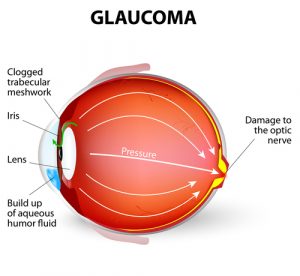Have you recently found out you have glaucoma? It’s more prevalent than you may think, as it’s a common age-related eye condition.
You may not realize that glaucoma is also one of the leading causes of blindness in adults over 60. While glaucoma often does lead to blindness, there are things you can do to preserve your vision.
There is no cure for glaucoma, meaning that any damage it causes to your vision is irreversible. However, treatments are available to slow down the condition’s progression and further vision loss.
One of the keys to keeping glaucoma under control is to receive an early diagnosis. From there, you can start treatment before experiencing any visual symptoms. Keep reading to learn more about glaucoma treatment and why it’s a viable option!
What is Glaucoma?

Glaucoma is the name given to a collection of eye diseases that damage the eye’s optic nerve. The optic nerve connects your eyes and your ability to see to your brain.
When this becomes damaged, it can’t send all the information about what you see to your brain. Patients with advanced glaucoma experience peripheral vision loss and eventually begin to encounter tunnel vision.
In most cases, optic nerve damage occurs when pressure is too high in the eye. Your eyes have aqueous in them, a clear fluid flowing through various chambers in the eye to keep them clean and healthy.
When the channels that aqueous flows through get blocked off, intraocular pressure, or IOP, builds and eventually causes irreversible damage to the optic nerve.
Open-Angle and Angle-Closure Glaucoma
Open-angle glaucoma is the most common form of glaucoma. Pressure builds up in the eye because the trabecular meshwork, which is porous tissue that fluid in the eye flows through, becomes blocked.
But your eye’s man drainage angle, the channel between the iris and cornea, remains open. Pressure builds very slowly in patients with open-angle glaucoma.
Those with open-angle glaucoma may not experience any symptoms for years. But the damage is already done once they start experiencing symptoms like blind spots in their peripheral vision and tunnel vision.
It’s permanent and irreversible, illustrating the need for eye exams. Scheduling routine eye exams are the only way to have glaucoma diagnosed before you experience symptoms or start losing your vision.
Angle-Closure Glaucoma
On the other hand, angle-closure glaucoma is rarer. Unlike other forms of glaucoma, angle-closure glaucoma often presents immediate symptoms, like nausea, vomiting, eye pain, blurred vision, and redness.
It occurs when the iris bulges and blocks off the primary drainage angle. In acute angle-closure glaucoma, the pressure builds up suddenly and requires emergency medical treatment to prevent permanent damage.
Because open-angle glaucoma is the most common form of glaucoma, most treatments are made for it, focusing on lowering IOP to prevent further optic nerve damage.
Treating Glaucoma

Although glaucoma has no cure, various options are available to treat the eye condition. How your ophthalmologist treats glaucoma depends on a few factors, like the severity of your symptoms, what kind you have, and how aggressive your vision loss is.
Medication
For mild cases of glaucoma especially, medication is an effective form of treatment. The most common medication for glaucoma is eye drops that aim to lower your intraocular pressure levels.
To remain effective, you must take these eye drops continuously and as directed by your eye doctor.
Glaucoma Surgery
There are several kinds of traditional glaucoma surgeries available. The most well-known procedure for treating glaucoma is a trabeculectomy.
The procedure involves creating an opening in the eye’s front chamber to add another drainage channel. Giving the aqueous another means of draining from the eye alleviates pressure, lowering IOP.
Another common surgical technique is inserting a shunt. A shunt is a drainage device that can further aid in alleviating pressure.
A newer technique is canaloplasty, which expands Schlemm’s canal in your eye. Schlemm’s canal allows aqueous to flow through your eye. By making the canal larger, more aqueous can drain and help alleviate additional pressure.
Laser Surgery
Laser surgical glaucoma procedures utilize traditional techniques and laser technology to lower IOP. These procedures can do this in several ways.
A laser trabeculectomy is a procedure that is less invasive than a traditional trabeculectomy. It uses a laser on the trabecular meshwork, removing blockages to provide better fluid drainage.
Another standard laser treatment for glaucoma is called photocoagulation. Photocoagulation uses lasers to alter cells in some parts of the eye, making them produce less fluid.
For patients with angle-closure glaucoma, a procedure called a laser iridotomy may be performed. A laser iridotomy uses a laser to create a small hole in the iris to alleviate the intense build-up of pressure when it bulges and closes the primary drainage angle.
MIGS
Micro Incisional Glaucoma Surgeries, or MIGS, are procedures derived from traditional glaucoma surgeries. Unlike these conventional glaucoma procedures, MIGS uses fewer incisions and smaller devices.
MIGS are less invasive than traditional glaucoma surgeries, and the recovery time is much faster. However, MIGS is only recommended for patients with mild to moderate glaucoma, as advanced glaucoma requires more intensive treatment.
There are many viable options for glaucoma treatment, but they all aim to prevent further damage. To prevent vision loss, you need to have regular eye exams so your eye doctor can diagnose glaucoma in the early stages.
They can then recommend treatment tailored to your needs. Depending on the severity of the condition, you may need a combination of treatments.

But by staying on top of your eye health and receiving early treatment, you can ensure that you keep your vision for many more years. Do you need to learn more about glaucoma treatment options? Find out what’s available to you by scheduling an appointment at Sierra Nevada Eye Center in Reno, NV, now!


